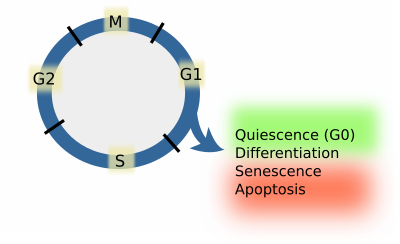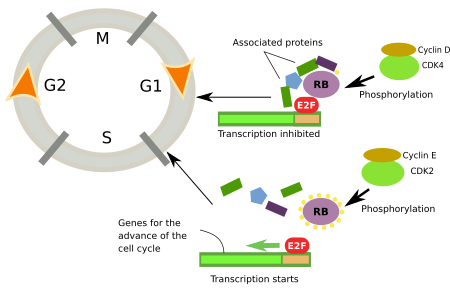The G1 phase (G stands for gap) spans from the end of mitosis to the start of the S phase. During the G1 phase, the cell checks the external environment and the intracellular state, and decides whether to continue with the cell cycle, stop, or abandon it. It is not only the current state of the cell that is crucial, but also the previous history of events that the mother cell underwent. In multicellular organisms, the cell cycle progress is largely influenced by extracellular signals, like cell adhesion, or molecules released by other cells, such as trophic factors, survival factors, and so on. There is also internal information about the state of the cell that affects the progress of the cell cycle, like its own health condition, if there is a correct number of cellular components after cell division, or if chromosomes were properly segregated during the previous M phase. When external and internal signals are favorable, proliferating cells grow and get ready to enter S phase.
One main function of the G1 phase is to couple proliferation and cell growth. Thus, the smaller the cell, more the time it spends in the G1 phase. The cell size is sensed by the cell through the concentration of some molecules. The smaller the size, the higher is the concentrartion. It is palusible that cells continue with the cell cycle afte a threshold concentration of specific molecules is reached. The dilution of inhibitors of the cell cycle due to the enlarge of the cytoplasm allows the advance to the S phase. However, activators of the cell cycle may keep the concentration by a constant gene expression.
1. Quiting the cell cycle
However, most cells of multicellular organisms do not proliferate, but quit the cell cycle in the G1 phase, either transiently or permanently. Stopping the cell cycle means that the cell is going to differentiate, stay quiescent, go through a senescence process, or die by apoptosis (Figure 1). When a cell remains in a quiescent state, it is said that it is in the G0 phase. In G0 and differentiated states, some cell types are able to restart the cell cycle. Entering the quiescent stage means the expression of a particular set of genes and the repression of those genes that promote differentiation, senescence or apoptosis. Quiescent cells repressed many genes, including those promoting the cell cycle. After apoptosis, or senescence, cells cannot return to the cell cycle. The other decision a cell can take is to go on with the cell cycle.

2. Checkpoints
Checkpoints are molecular complexes that control the progress of the cell cycle. At the end of the G1 phase, there is a checkpoint that controls the G1-S phase transition. If the cell stops in the G1 and does not pass the G1 checkpoint, it is said the cell made a decision. The default process in proliferating cells is to get everything ready to pass the G1 checkpoint. The molecular mechanism at the checkpoint has to be fast, precise and complete. The checkpoint concept was introduced in 1974 by A. Pardee. It is a critical decision to pass the G1 checkpoint, because once DNA replication is initiated in the S phase, there is no turning back, and the cell will divide.
At the core of checkpoints, there are cyclin-dependent kinases (CDKs). Nine different CDKs have been found in eukaryotes. To be active, CDKs need to bind a regulatory protein known as cyclin, and be phosphorylated as well. Once activated, CDKs phosphorylate several substrates, such as inhibitors of the cell cycle, thus allowing the progress of the cell cycle. Cyclins are proteins synthesized periodically during the cell cycle. The CDK4/cyclin D (D/CDK4) and the CDK2/cyclin E (E/CDK2) are present during the G1 phase (Figure 2).

3. Replication origin licensing
Another event happening at the G1 phase is licensing the points where the DNA will start to be replicated during the S phase. These points are known as the origins of replication. Thus, molecular complexes join specific points of the chromatin that label the points where the replication machinery will join. In eukaryotic cells, there are many origins of replication because of their many chromosomes and large DNA strands. The replication origin licensing begins when the ORC (origin recognition complex) joins the DNA, and then CDC6 and CDT1 load the MCM replication helicase. All these molecules are expressed under the control of E2F (see figure 2). In yeasts, if some of these licensing proteins are mutated, cells still enter the S phase and get divided, but the DNA is not replicated. In mammalian cells, however, there is some type of checking to ensure there are enough licensed origins of replication before entering the S phase.
-
Bibliography ↷
-
Bibliography
Blomen VA, Boonstra J. 2007. Cell fate determination during G1 phase progression. Cellular and molecular life sciences. 64:3084-3104.
Matson JP, Cook JG. 2017. Cell cycle proliferation decisions: the impact of single cell analyses. The FEBS journal. 284: 362-375.
-
 Cell cycle
Cell cycle